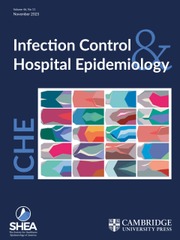Crossref Citations
This article has been cited by the following publications. This list is generated based on data provided by
Crossref.
Comeau, Nicholas P.
2016.
Recognition, management, and prevention of burn sepsis in pediatric patients.
Nursing Critical Care,
Vol. 11,
Issue. 6,
p.
24.
Clemons, Julia
and
Kearns, Mark
2016.
Invasive Mechanical Ventilation.
Hospital Medicine Clinics,
Vol. 5,
Issue. 1,
p.
17.
Kampf, G.
2016.
Acquired resistance to chlorhexidine – is it time to establish an ‘antiseptic stewardship’ initiative?.
Journal of Hospital Infection,
Vol. 94,
Issue. 3,
p.
213.
Jaillette, E.
Ledoux, G.
Lawson, R.
Misset, B.
and
Nseir, S.
2016.
Pneumonie acquise sous ventilation mécanique : quoi de neuf en 2016 ?.
Réanimation,
Vol. 25,
Issue. S2,
p.
83.
Blakeman, Thomas
Rodriquez, Dario
Woods, James
Cox, Daniel
Elterman, Joel
and
Branson, Richard
2016.
Automated control of endotracheal tube cuff pressure during simulated flight.
Journal of Trauma and Acute Care Surgery,
Vol. 81,
Issue. 5,
p.
S116.
Tsalik, Ephraim L.
Li, Yanhong
Hudson, Lori L.
Chu, Vivian H.
Himmel, Tiffany
Limkakeng, Alex T.
Katz, Jason N.
Glickman, Seth W.
McClain, Micah T.
Welty-Wolf, Karen E.
Fowler, Vance G.
Ginsburg, Geoffrey S.
Woods, Christopher W.
and
Reed, Shelby D.
2016.
Potential Cost-effectiveness of Early Identification of Hospital-acquired Infection in Critically Ill Patients.
Annals of the American Thoracic Society,
Vol. 13,
Issue. 3,
p.
401.
Kalil, Andre C.
Metersky, Mark L.
Klompas, Michael
Muscedere, John
Sweeney, Daniel A.
Palmer, Lucy B.
Napolitano, Lena M.
O'Grady, Naomi P.
Bartlett, John G.
Carratalà, Jordi
El Solh, Ali A.
Ewig, Santiago
Fey, Paul D.
File, Thomas M.
Restrepo, Marcos I.
Roberts, Jason A.
Waterer, Grant W.
Cruse, Peggy
Knight, Shandra L.
and
Brozek, Jan L.
2016.
Management of Adults With Hospital-acquired and Ventilator-associated Pneumonia: 2016 Clinical Practice Guidelines by the Infectious Diseases Society of America and the American Thoracic Society.
Clinical Infectious Diseases,
Vol. 63,
Issue. 5,
p.
e61.
Camus, Christophe
Sauvadet, Elise
Tavenard, Aude
Piau, Caroline
Uhel, Fabrice
Bouju, Pierre
Letheulle, Julien
Dollo, Gilles
Gacouin, Arnaud
Lavoué, Sylvain
and
Le Tulzo, Yves
2016.
Decline of multidrug-resistant Gram negative infections with the routine use of a multiple decontamination regimen in ICU.
Journal of Infection,
Vol. 73,
Issue. 3,
p.
200.
Dres, Martin
Mancebo, Jordi
and
Curley, Gerard F.
2016.
Update in Critical Care 2015.
American Journal of Respiratory and Critical Care Medicine,
Vol. 194,
Issue. 1,
p.
19.
Timsit, Jean-Francois
Esaied, Wafa
Neuville, Mathilde
Bouadma, Lila
and
Mourvillier, Bruno
2017.
Update on ventilator-associated pneumonia.
F1000Research,
Vol. 6,
Issue. ,
p.
2061.
Mack, Elizabeth H.
and
Stem, Christopher T.
2017.
Prevention of CAUTIs, CLABSIs, and VAPs in Children.
Current Treatment Options in Pediatrics,
Vol. 3,
Issue. 3,
p.
221.
Khan, Mohammad
Mohamed, Zeehaida
Ali, Saedah
Saddki, Norkhafizah
Masudi, Sam’an Malik
and
Sukminingrum, Ninin
2017.
Oral Care Effect on Intubated Patient with 0.2 per cent Chlorhexidine Gluconate and Tooth Brushing in Intensive Care Unit.
Journal of Advanced Oral Research,
Vol. 8,
Issue. 1-2,
p.
26.
Veitz-Keenan, Analia
and
Ferraiolo, Debra M
2017.
Oral care with chlorhexidine seems effective for reducing the incidence of ventilator-associated pneumonia.
Evidence-Based Dentistry,
Vol. 18,
Issue. 4,
p.
113.
Póvoa, Pedro
Lisboa, Thiago
and
Paiva, José-Artur
2017.
Ventilator-associated pneumonia prevention: one good turn does not always deserve another.
Intensive Care Medicine,
Vol. 43,
Issue. 12,
p.
1872.
Su, Kang-Cheng
Kou, Yu Ru
Lin, Fang-Chi
Wu, Chieh-Hung
Feng, Jia-Yih
Huang, Shiang-Fen
Shiung, Tao-Fen
Chung, Kwei-Chun
Tung, Yu-Hsiu
Yang, Kuang-Yao
Chang, Shi-Chuan
and
Lazzeri, Chiara
2017.
A simplified prevention bundle with dual hand hygiene audit reduces early-onset ventilator-associated pneumonia in cardiovascular surgery units: An interrupted time-series analysis.
PLOS ONE,
Vol. 12,
Issue. 8,
p.
e0182252.
Schreiber, Matthew P
and
Shorr, Andrew F
2017.
Challenges and opportunities in the treatment of ventilator-associated pneumonia.
Expert Review of Anti-infective Therapy,
Vol. 15,
Issue. 1,
p.
23.
Yoshimura, Jumpei
Kinoshita, Takahiro
Yamakawa, Kazuma
Matsushima, Asako
Nakamoto, Naoki
Hamasaki, Toshimitsu
and
Fujimi, Satoshi
2017.
Impact of Gram stain results on initial treatment selection in patients with ventilator-associated pneumonia: a retrospective analysis of two treatment algorithms.
Critical Care,
Vol. 21,
Issue. 1,
Murthy, Srinivas
Pathan, Nazima
and
Cuthbertson, Brian H.
2017.
Selective digestive decontamination in critically ill children: A survey of Canadian providers.
Journal of Critical Care,
Vol. 39,
Issue. ,
p.
169.
Cutler, Gretchen J.
Kharbanda, Anupam B.
Nowak, Jeffrey
and
Ortega, Henry W.
2017.
Injury Region and Risk of Hospital-Acquired Pneumonia Among Pediatric Trauma Patients.
Hospital Pediatrics,
Vol. 7,
Issue. 3,
p.
164.
Alves, Joana
Peña-López, Yolanda
Rojas, José N.
Campins, Magda
and
Rello, Jordi
2018.
Can We Achieve Zero Hospital-Acquired Pneumonia?.
Current Treatment Options in Infectious Diseases,
Vol. 10,
Issue. 2,
p.
153.




